Repairing leaking cracks in concrete block walls is a common challenge for many homeowners. There are the many common fixes available that do not last. Urethane caulk, which is very easy to apply has no strength and will soon peel need to be replaced. There is also hydraulic cement, which is inexpensive but will separate quickly and then crumble as the wall moves slightly.
Foundation Crack Injection Kits are ideal for cracks in poured concrete walls but cannot be used on concrete blocks. The expanding polyurethane foam or injected epoxy would run into the hollow cores of the blocks. And you cannot use the pure ElastiPoxy™ Joint & Crack Filler either because it would run out.
Another common problem for homeowners is old leaking cinder blocks that have deteriorated after years of water seepage and efflorescence and which even RadonSeal Concrete Sealer cannot fully waterproof. Common waterproofing paints or any coating would soon fail, pushed off by water pressure and efflorescence.
The only reliable cement crack filler solution is ElastiPoxy™ Joint & Crack Filler mixed with sand, which provides a strong, rigid, and permanent repair of cracks or defects in walls or slabs. The cement crack filler mix adheres tenaciously to concrete. The cured repair is much stronger than the concrete itself.
Applications for the ElastiPoxy-sand mix:
- Surface cracks, holes, or defects in poured concrete walls, honeycombed concrete, leaking form ties.
- Cracks in concrete block walls or missing mortar.
- Leaking deteriorated concrete blocks, blocks with large pinholes, hard-to-seal concrete blocks.
- Cracks in brick walls and mortar.
- Spalls, pitting, or holes in concrete driveways, slabs, and floors.
Do not use the rigid epoxy-sand mix on joints or cracks that have to move! That requires the pure ElastiPoxy™ Joint & Crack Filler to allow for the natural expansion and contraction of concrete.
Sand:
The sand must be dry! Use granular sand without fines, like play sand or construction sand. Readily available in stores and inexpensive.
Sand to epoxy ratio:
The typical ratio is 4 parts of sand to 1 part of epoxy. If the mix sags out of the cracks, add more sand to make it stiffer.
Dry surfaces:
The inside surfaces of the crack must be dry (although ElastiPoxy has a certain tolerance for damp surfaces).
Appearance:
The cured epoxy-sand mixture has a texture and color similar to concrete or mortar. Colored sand or color pigments may be mixed in if needed.
Repairing Cracks in Concrete Walls
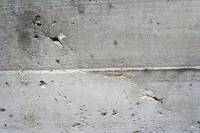
Locate cracks or defects in the concrete wall.
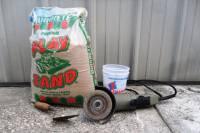
The ElastiPoxy kit, which includes measuring cups and a mixer, and a bag of play sand.
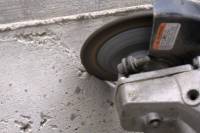 Chase the crack to 1/2″ minimum depth using a 4″ right-angle grinder or diamond crack chaser.
Chase the crack to 1/2″ minimum depth using a 4″ right-angle grinder or diamond crack chaser.
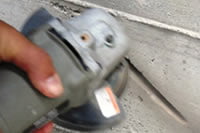 Chase the crack to 1/2″ minimum depth using a 4″ right-angle grinder or diamond crack chaser.
Chase the crack to 1/2″ minimum depth using a 4″ right-angle grinder or diamond crack chaser.
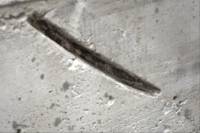
Routed crack ready for repair. It must be dry.
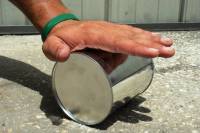
Roll the cans. The compounds are multiple viscosity products. Good mixing is important.
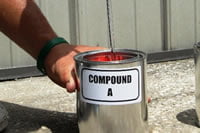
Mix each compound individually using the mixer in a slow speed drill. This is important!
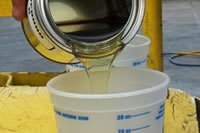
Carefully measure one part of Resin.
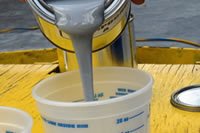
Carefully measure one part of Hardener.
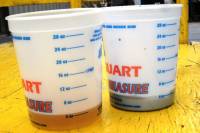
The amounts of Resin and Hardener must be equal.
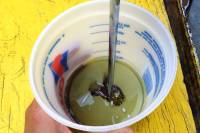
Combine Resin and Hardener in a cup or plastic pail and thoroughly mix.
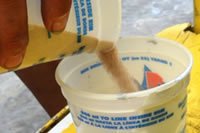
Add dry play sand at 4:1 sand-to-epoxy ratio and mix thoroughly with the mixer at slow speed.
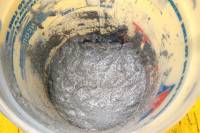
The epoxy-sand mixture. Let off gas for 15 minutes.
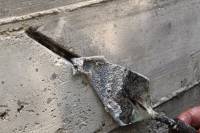
Using a small trowel apply the mix into the routed wall crack forcing it to the bottom of the groove.
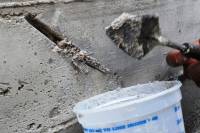
NOTE: If the mix sags out of the crack, just mix in more sand.
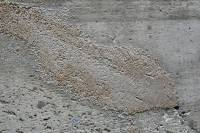
Full cure time is about 24 hours depending on humidity and temperature.